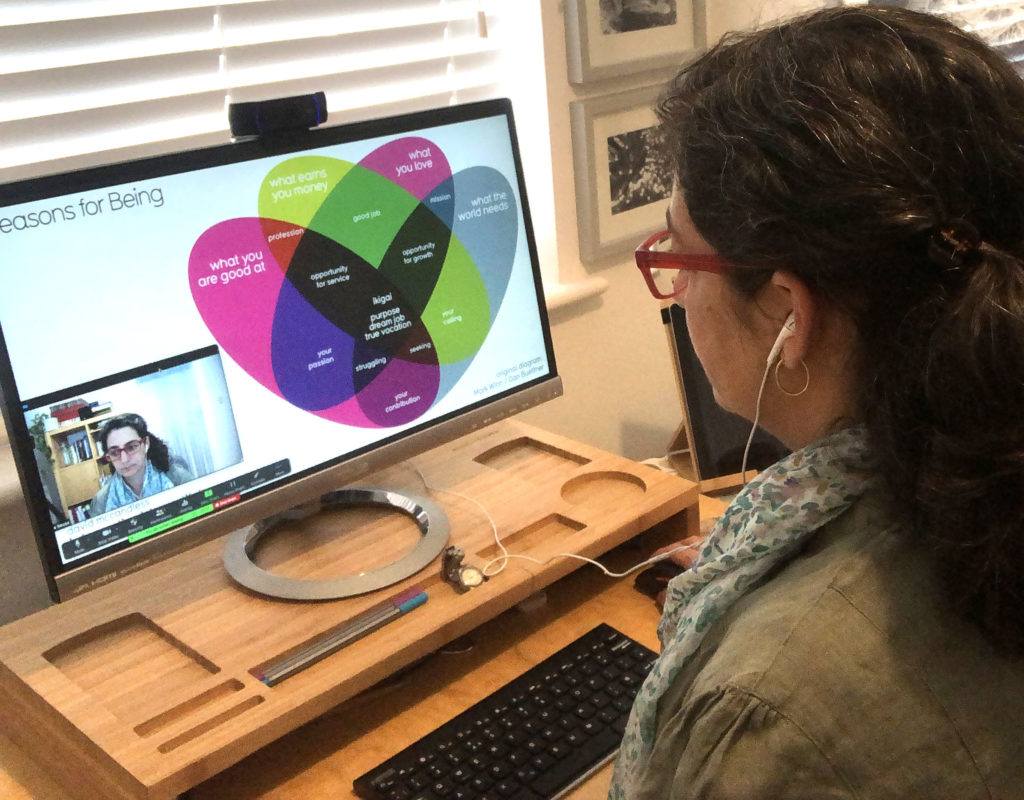First steps in the long journey of mass virtual education

One Monday in early March 2020 I was taking my class of American students on a field trip to the Olympic Park in London. By the next Monday, COVID-19 pandemic had reached the UK. From one week to the other, all my students had gone back to the USA. This is an account of what happened next.
At first, a sudden sadness filled me. I would not see my students in person again. We would not go on the last field trip planned for their semester in London. I would not be able to bring the guest speaker to class for a lively discussion on gender as I had planned. I later learned that what I was feeling was grief for the loss of what was supposed to be.
Then, panic hit. I was left to figure out how to continue teaching remotely. There were numerous resources for teachers on the college’s new ‘keep teaching’ microsite. Most of them were about the choice of tools available to us, from pre-recording lectures, discussions with voice thread tools, and hosting Zoom virtual classes.
I was not alone in freaking out. To alleviate the fear of a rapid transition from in-person to virtual classes, Michael Bruening, a historian professor at Missouri University, recorded I Will Survive, Coronavirus version for teachers going online. It became a YouTube hit with more than 2 million views. Whenever I needed to gain perspective to pull it together, I sang the chorus line to myself: ‘Oh, as long as I know how to Zoom, I know I’ll be alive’…
To be fair, technology was actually the least of my worries. With a background in engineering, I am known to be the techie person in most of the groups I belong to. On a practical level, I soon realised I had to make three key changes:
- To buy a new computer, as my seven-year-old laptop did not have the processing power required for sharing screens in large group calls;
- To install a backup internet, as my partner was now working from home and having video calls at the same time as me, demanding more bandwidth than before;
- To rearrange my home office furniture, so that all my mess laid hidden from view – after all, as I have written before, first impressions count and I was not going to take a risk.
Technology sorted, there were five abstract questions I was struggling with. I had a lot of soul searching to do:
1. How to bring the Whole Person Learning to a virtual environment?
Everything I have done in the last 10 years has been based on face-to-face interactions and no PowerPoint, combining activities to stimulate the Whole Person: mind, heart, body and soul. It would be impossible to provide the same dynamics in a virtual environment. I had to figure out what ‘good enough’ would look like.
Response. To focus on relationships and building trust. The connections and relationships that exist between I, We and All of us are at the core of the Whole Person Approach. I have been placing these at the centre of my practice before and there was no reason why that should stop now. I entered the virtual classroom with honesty and flexibility. For a start, I shared how anxious I was about it being my first ever virtual teaching. There was no pretending that this was ‘normal’ and that I knew what I was doing. I made it clear that it would be a shared learning journey for all of us.
At every stage, we were checking with each other if/how it was working for the group. Since I did not have all the answers and I was making changes to the course as we went along, there was a fair amount of flexibility built-in. The assignments and deadlines had to be adapted and students were able to input into the process. I believe this sense of ownership increased their sense of commitment.
2. How to engage with the lower attention-span of virtual environments?
In a classroom, I get students to get up and move around to keep their minds and bodies attentive. I had no idea how to make this work in the virtual environment.
Response: To mix online and offline activities. Instinctively I knew that replacing a three-hour face-to-face class with a three-hour virtual class would provoke a similar state as death by PowerPoint. Therefore, I decided to move all content-based teaching to self-learning and have only a one-hour weekly Zoom virtual class.
- In the virtual class we basically touched base (see response 3), talked about how everyone was doing, considered any changes to the material, assignments and deadlines and discussed how the changes in the world around us brought by the pandemic related to the topics we were studying in the module. This made the time we spent together relevant and practical.
- The self-learning element was divided into four parts for students to complete on their own pace: (1) ‘watching time’ with recommended movies, TV series, TED talks, and a pre-recorded interview with the gender guest speaker; (2) ‘reading time’ with a list of links and further reading (3) ‘research time’ where they had to pick one news story of the week related to that week’s topic; and (4) ‘self-reflection time’ where the students had to record a short video with the highlights of their self-learning and what it meant for their personal and professional life.
3. How to deal with students’ emotional state?
Previously I had used check-ins and paired conversation to bring their emotions to the room. I had no clue if and how this could work in a virtual class or what to do if there was a breakdown during the class. How to offer a safe virtual environment?
Response: To give check-ins/check-outs centre stage. I knew that now, more than ever, ignoring emotions would hinder learning. Instead of pretending we could simply turn a switch from face-to-face to virtual, I decided to spend approximately a third of the time in the weekly Zoom class talking about how we were – how we really were. Structured check-ins and check-outs allowed us to share what was going on in each of us at the start and at the end of each call. Acknowledging emotions is a powerful tool. It enabled us to move on to the discussion part of the class with a shared understanding of one another and where each of us was. We always closed the call in a better place than we started it.
4. How to replace the experience of a field trip?
A key part of the course is getting students to places so that they can have a felt sense of the issues being discussed. The closest I could think of was to have a virtual reality tour. Unfraternally, the natural reserve we were planning to go to does not offer such a tour (yet). Needless to say, I was lost. But I had to find a way out.
Response: To rely heavily on the power of images. People say that a picture is worth a thousand words. I expanded that concept and adopted documentaries as part of the ‘watching time’. There is some really good material online. For example, the Channel 4 Dispatches series on Breadline Kids and BBC’s Love and drugs in the streets series showed students a different Britain than the one they got to know when they were living and studying in central London. Whereas David Attenborough’s new series Our Planet allowed students to get immersed in nature without leaving their homes. Combined, these and other documentaries, news clips and TED talks gave a deep sense of life outside students’ bubbles.
5. How to ‘read the room’ in virtual classes?
Any teacher or facilitator will know how important it is to ‘read the room’ and spot when the energy drops and when students need a comfort break. It is something that is so automatic that you don’t even notice you are doing it. But, reading the body language is one of those things that are difficult to do in a virtual environment – you see lots of rectangles and faces, but no bodies!
Response: An incomplete skill which we will develop by doing. Having all faces in a gallery view gives you a sense of the whole, but then you miss the focus on the person speaking. If you use the speaker view and place the speaker on full screen, then you lose the sense of the group. There is nothing to replace the peripheral vision we have in face-to-face group discussion. It is not possible either to make eye contact, followed by nodding of the head, to acknowledge someone else wanting to speak and that their turn will come next. I just accepted that reading the room in a virtual classroom is really hard and almost impossible. We will develop strategies the more we do it, but at the moment, we’ll have to live with this shortfall.
It was not easy. But we – myself and the students – got through it. In fact, I believe some of the content was better absorbed through the documentaries than my oratory in face-to-face classes. The feedback from the students was positive and they valued being able to have a say in the changes. Hearing from each other also helped them to feel they were not alone and to put things in perspective.
I heard other teachers had opted for other course structures. I believe there is not a one size fits all approach. What I described here was my experience with what I suspect was the first of many classes I will give virtually. Colleges are already considering moving their classes online in the Autumn term. No one knows when we will return and the implications of new safety requirements. The higher education sector will face a number of challenges as we re-integrate to what will be a new normal. I believe a greater mix of online, offline and face-to-face education will be part of the future. Nevertheless, we are all just taking the first steps into a very long journey into mass virtual learning. May our journey begin.
